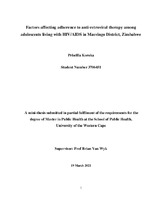| dc.description.abstract | Background: With the improvements in the effectiveness and availability of antiretroviral therapy (ART), perinatally infected children are surviving to adolescence and emerging as a significant sub-population living with HIV/AIDS in Zimbabwe. Adolescents, aged 10-19 years, face unique challenges related to adherence to chronic medication due to this period of vulnerability that is characterised by decreased parental support and supervision, decreased inhibition, increased risk-taking, and immature judgement. It is widely reported that poor adherence to ART leads to viral rebound, disease progression and drug resistance, in addition to increasing the risk of transmitting resistant strains of HIV to others. It is imperative to determine the factors that influence ART adherence among HIV positive adolescents so that effective interventions can be put in place. The current study described the factors that are associated with adherence to ART among HIV positive adolescents in Zimbabwe. Methodology: A cross-sectional survey of 136 randomly selected adolescents (10-19 years) who were receiving ART at two referral hospitals in Masvingo District in 2019 was undertaken. A questionnaire was administered to collect data on socio-demographic characteristics, adherence and factors related to adherence such as person/patient, health system, medication, disease characteristics and social factors. Clinical data were extracted from the Electronic Monitoring Patient System. SPSS v24 was used for descriptive and inferential analysis. Results: More than half of the participants (61%) had combined optimal adherence (dose adherence, schedule adherence and adhered to dietary instructions) in the previous three days. The most frequent reasons reported for missing HIV medications in the previous month was being away from home (50%); forgetfulness (25%); and having too many pills to take (25%). In bivariate analysis, only duration of time since HIV diagnosis was significantly associated with combined adherence to ART in the previous three days. Conclusion: Tailored interventions are recommended to address low adherence amongst adolescents. These interventions should include convenient clinic appointment schedules for adolescents to pick up medication, reminders to take medication, regimen change to a single dose, and peer education and adherence clubs to improve knowledge about HIV and treatment, and curb treatment fatigue. | en_US |

